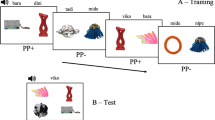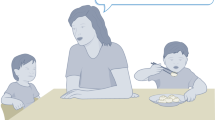Abstract
Phonological and grammatical analyses of child language have concentrated on finding a system in the child's production or in its relationship to the adult target. This paper suggests that a stage of item-learning applies at various levels of language (phonology, intonation, morphology and syntax, and semantics) before a stage of system-learning. System-learning may involve segmentation and subsequent substitution; the separation of two simultaneously operating systems; or the pairing of a set of referents with one form.
Similar content being viewed by others
References
Bloom, L., Hood, L., and Lightbown, P. (1974). Imitation in language development: if, when and why.Cog. Psychol. 6:380–420.
Branigan, G. (1976). Syllabic structure and the acquisition of consonants: the great conspiracy in word formation.J. Psycholing. Res. 5(2):117–133.
Brown, R. (1973).A First Language: The Early Stages, Harvard University Press, Cambridge, Mass.
Clark, E. V. (1973). What's in a word? On the child's acquisition of semantics in his first language. In Moore, T. E. (ed.),Cognitive Development and the Acquisition of Language, Holt, Rinehart, and Winston, New York.
Clark, R. (1974). Performing without competence.J. Child Lang. 1(1):1–10.
Clark, R. (1977). What's the use of imitation?J. Child Lang. 4(3):341–358.
Cruse, D. A. (1977). A note on the learning of colour names.J. Child Lang. 4(2):305–311.
Cruttenden, A. (1978). The acquisition of personal pronouns and language simplification.Lang. Speech 21:191–197.
French, P., MacLure, M., and Pearson, M. (1978). Practice as a strategy in language acquisition. Presented at Child Language Seminar, York, 1978.
Halliday, M. A. K. (1975).Learning How to Mean—Explorations in the Development of Language, Edward Arnold, London.
Kiparsky, P., and Menn, L. (1977). On the acquisition of phonology. In Macnamara, J. (ed.),Language, Learning and Thought, Academic, New York.
Peters, A. M. (1977). Language learning strategies: does the whole equal the sum of the parts?Language 53:560–573.
Reich, P. A. (1976). The early acquisition of word-meaning.J. Child Lang. 3(1):117–123.
Vygotsky, L. A. (1962). in Hanfmann, E., and Vakar, G. (eds. and translators),Thought and Language, MIT Press, Cambridge, Mass.
Author information
Authors and Affiliations
Rights and permissions
About this article
Cite this article
Cruttenden, A. Item-learning and system-learning. J Psycholinguist Res 10, 79–88 (1981). https://doi.org/10.1007/BF01067363
Accepted:
Issue Date:
DOI: https://doi.org/10.1007/BF01067363




